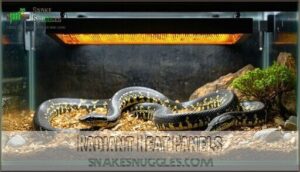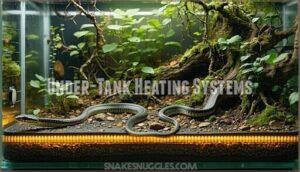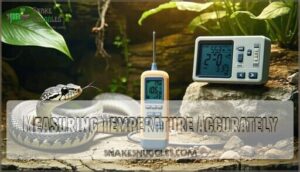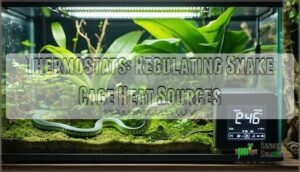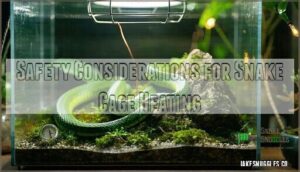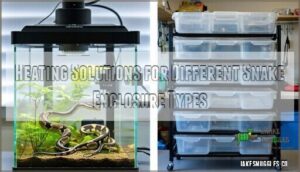This site is supported by our readers. We may earn a commission, at no cost to you, if you purchase through links.
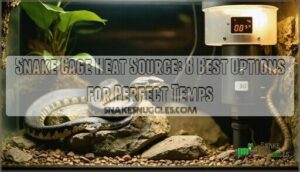
Heat mats work great for belly warmth, while ceramic heat emitters provide consistent ambient heat without light. Under-tank heaters are perfect for nocturnal species, and radiant heat panels offer gentle, even warming.
Heat lamps give you excellent temperature control but can dry out the enclosure. Always use a thermostat – it’s your safety net against overheating disasters.
Most snakes need a temperature gradient with basking spots around 88-92°F and cool zones at 75-80°F. The secret lies in matching your heating method to your snake’s natural behavior and your specific enclosure setup, which is crucial for creating a comfortable environment with the right temperature control and heat source to ensure your snake’s health and happiness, and to provide a safe and healthy space.
Table Of Contents
- Key Takeaways
- Essential Heat Sources for Snake Enclosures
- Creating Optimal Temperature Gradients in Snake Habitats
- Thermostats: Regulating Snake Cage Heat Sources
- Safety Considerations for Snake Cage Heating
- Heating Solutions for Different Snake Enclosure Types
- Balancing Heat and Humidity in Snake Cages
- Energy-Efficient Snake Cage Heating Methods
- Troubleshooting Common Snake Cage Heating Problems
- Frequently Asked Questions (FAQs)
- What is the best heat source for a snake enclosure?
- What are the sources of heat for snakes?
- What is the best heat source for a PVC enclosure?
- How to keep a snake enclosure warm?
- How to heat reptile enclosures?
- What is the cheapest way to heat a vivarium?
- What is the ideal temperature for a ball pythons cage?
- How do I choose the right heat source for my snake?
- Can I use a heat rock as a heat source?
- How do I maintain a consistent temperature in my snakes cage?
- Conclusion
Key Takeaways
- Always use a thermostat – It’s your safety net against overheating disasters that can harm or kill your snake, and quality models like Herpstat prevent dangerous temperature swings.
- Create proper temperature gradients – You’ll need basking spots around 88-92°F and cool zones at 75-80°F so your snake can regulate its body temperature naturally.
- Match heating methods to your snake’s behavior – Nocturnal species thrive with under-tank heaters, while active species need overhead basking lamps for proper thermoregulation.
- Choose the right heat source for your enclosure type – Heat mats work great for plastic tubs, radiant panels excel in PVC enclosures, and ceramic emitters provide consistent 24/7 heat without disrupting sleep cycles.
Essential Heat Sources for Snake Enclosures
You’ll need to choose the right heat source to keep your snake healthy and comfortable.
The key is matching your heating method to your snake’s natural behavior and your enclosure setup, which is a complete concept to consider for the snake’s well-being.
Heat Mats and Their Benefits
Heat mats are your simplest heating option for snake enclosures, delivering consistent bottom heat that creates the perfect thermal gradient.
Heat mats deliver steady warmth from below—your snake’s personal heating pad that never quits.
These under tank heaters provide low-level heat delivery from below, making them ideal for nocturnal species who naturally seek warmth from heated surfaces. Unlike overhead heating, heat mats won’t disrupt your snake’s day-night cycle while maintaining essential temperatures.
The beauty of reptile heat mats lies in their reliability – they’re like having a steady campfire that never goes out. With proper thermostat control, you’ll maintain precise temperatures without worrying about overheating or cold spots.
Here are four key benefits of using heat mats for snake heating:
- Energy efficiency – Heat mats consume minimal electricity while providing steady warmth
- Silent operation – No fans or moving parts to disturb your snake’s peace
- Long lifespan – Quality heat mats can last years with proper maintenance
- Easy installation – Simply place under your enclosure and connect to a thermostat
Remember, heat mats work best when combined with proper insulation and accurate temperature monitoring for ideal reptile heat distribution. You can find various snake enclosure supplies online for superior setup.
Ceramic Heat Emitters
Ceramic heat emitters (CHEs) deliver infrared radiation without light, making them ideal for 24/7 heating.
These ceramic heat emitters provide consistent reptile heat while preserving your snake’s natural day-night cycle.
With impressive CHE lifespan lasting up to five years, they’re cost-effective snake cage heat source options.
Many reptile owners find various products available to suit their needs.
Always install protective guards around CHEs to prevent burns from direct contact with this powerful heating method.
Radiant Heat Panels
Radiant heat panels are the gold standard for snake enclosure heating—think of them as a cozy sunbeam you install.
They’re quiet, safe, and perfect for PVC enclosures.
Choose the right Panel Wattage for your Enclosure Size and Species Needs.
With proper Installation Safety, these panels outshine undertank heating systems as a reliable snake cage heat source, keeping your snake comfy day and night, using radiant heat to create a cozy environment, which is the perfect solution.
Heat Lamps and Bulbs
While radiant heat panels offer excellent overhead warmth, heat lamps bring something special to the table—they’re like miniature suns for your snake’s world.
Heat lamps are important because they help snakes with vital metabolic processes.
There are several types of heat lamps available, including:
- Basking Bulbs create focused hotspots that mimic natural sunlight, with halogen lamps offering deep tissue warming
- Infrared Bulbs provide nighttime heat without disturbing your snake’s sleep cycle
- Mercury Vapor bulbs deliver both heat and UVB output for species requiring UV exposure
- Heat projector bulbs offer energy-efficient infrared heat with longer lifespans than traditional options
Remember: heat lamp safety starts with protective guards—burns happen fast!
Under-Tank Heating Systems
Under your snake’s enclosure, under tank heater systems work like a gentle heating pad, creating perfect bottom-up warmth.
These heat mats require thermostat control to prevent dangerous overheating that could harm your reptile.
Installation safety matters—ensure proper airflow and substrate impact considerations.
Different species needs determine ideal UTH wattage for your snake habitat and reptile enclosure.
Creating Optimal Temperature Gradients in Snake Habitats
You need to create temperature gradients that let your snake regulate its body heat naturally, just like they do in the wild.
Getting this right means understanding how basking spots, cool zones, and day-night cycles work together to keep your snake healthy and comfortable, which involves creating an environment that mimics the natural day-night cycles.
Basking Spots and Cool Zones
Within your snake’s enclosure, you’ll need to establish a thermal gradient that mimics nature’s own temperature playground.
Position basking spots on one end where temperatures reach species-specific highs, while maintaining cool zones on the opposite side.
This temperature gradient allows natural thermoregulation behavior, letting your snake choose its ideal comfort zone throughout the day.
Proper ranges improve snake’s immune function.
Daytime and Nighttime Temperature Variations
Why not synchronize your snake’s heating with nature’s rhythm?
Most snakes need cooler nocturnal temperature drops to maintain their natural circadian rhythm.
You’ll create proper thermoregulation behavior by using thermostat control to manage the day-night cycle.
Different species needs vary – some nocturnal species actually prefer warmer nights while diurnal ones need cooler evenings.
This temperature gradient supports healthy seasonal adjustments and proper ambient temperature control.
Measuring Temperature Accurately
Accurate temperature readings start with proper thermometer placement. Position digital thermometers at both your hot spot and cool side to monitor the temperature gradient.
Digital vs analog? Go digital for precision. Check calibration methods regularly against a reference thermometer.
Infrared accuracy helps measure surface temps, while probe thermometers give ambient temperature readings.
Consistent readings guarantee your thermostat control works properly.
Adjusting Heat for Different Snake Species
Understanding your snake’s biological blueprint is essential for creating the perfect thermal environment.
Different snake species have evolved in distinct habitats, requiring specific temperature ranges to thrive.
- Ball pythons need 88-92°F basking spots with 78-80°F cool sides
- Corn snakes prefer 85-90°F warm zones and 75°F cool areas
- Boa constrictors require 85-90°F basking with high-70s cool zones
- Desert species need higher temperatures than tropical counterparts
- Nocturnal snakes benefit from gentler under-tank heating systems
Species-specific temperature needs depend on habitat specifics and snake size.
Diurnal vs. nocturnal behavior affects heating choices, while seasonal adjustments may be necessary.
Snakes generally thrive within a 70-90°F range, which is ideal for their activity and wellbeing.
Your thermostat control system should maintain proper temperature gradients across your snake enclosure temperature zones.
Thermostats: Regulating Snake Cage Heat Sources
You can’t just plug in a heat source and hope for the best – your snake’s life depends on precise temperature control through a quality thermostat.
Think of it as your snake’s personal climate control system, automatically adjusting heat output to maintain those perfect basking and cooling zones that keep your reptile healthy and comfortable.
Types of Thermostats for Reptile Enclosures
Which thermostat will keep your snake’s temperature spot-on? You’ve got several smart options that’ll make temperature control a breeze.
On/Off Thermostats work like your home’s furnace – they switch heat sources completely on or off when temps drift. Perfect for heat mats since they handle the constant cycling without breaking down.
Dimming Thermostats gradually adjust power instead of flipping switches, which means your basking bulbs last longer and temps stay rock-steady. Think of it as a dimmer switch for your living room lights.
Pulse Thermostats send rapid electrical pulses to maintain precise control – they’re the gold standard for thermostat accuracy with advanced safety features.
- On/off models offer reliable, budget-friendly temperature control for basic setups
- Dimming thermostats prevent temperature swings while extending bulb lifespan
- Proportional thermostats provide the most precise control with advanced safety features
Setting Up and Calibrating Thermostats
Probe placement is everything – position your thermostat sensor where your snake actually hangs out, not stuck to glass or buried in substrate.
Thermostat calibration takes patience: use a reliable thermometer to check accuracy, then adjust settings until readings match.
This temperature consistency prevents those nasty temperature variations that stress your snake’s natural species thermoregulation processes.
Fail-Safe Features in Reptile Thermostats
Modern reptile thermostats pack serious safety features that’ll protect your snake from temperature disasters.
Quality temperature control units include automatic shut-offs when temps spike dangerously high, plus power outage memory to restore your settings instantly.
Here’s what separates top-tier thermostats from basic models:
- Automatic shut-offs prevent overheating by cutting power when temperatures exceed safe limits
- Power outage memory restores previous settings automatically when electricity returns
- Audible alerts sound warnings when temperatures drift outside your programmed range
- Temperature memory logs historical data to help you spot heating patterns and problems
- GFCI integration provides electrical safety protection against ground faults and short circuits
These failsafe features turn your thermostat into a reliable guardian that works around the clock, giving you confidence that your snake stays safe even when you’re not around to monitor things personally.
Accurate readings from snake cage thermometers are also essential for maintaining ideal temperatures.
Monitoring and Maintaining Thermostat Performance
Beyond basic installation, maintaining your thermostat’s accuracy keeps your snake comfortable year-round.
Check calibration frequency monthly using an independent thermometer—digital probe thermostats typically last 3-5 years with proper care.
Consider backup thermostats for peace of mind, especially during extreme weather.
Remote monitoring systems let you track temperature regulation from anywhere, catching issues before they become problems.
Replace probe sensors showing drift beyond acceptable ranges for reliable temperature control and to ensure your snake remains comfortable, which is crucial for its well-being, and provides peace of mind.
Safety Considerations for Snake Cage Heating
When you’re heating your snake’s enclosure, safety should be your top priority since improper heating can lead to burns, fires, or even death.
You’ll need to focus on four key areas: preventing burns and overheating, fire prevention measures, electrical safety, and proper placement of heating elements.
Preventing Burns and Overheating
After setting up your thermostat, safeguarding your snake from heating safety hazards becomes vital.
Proper ventilation prevents heat buildup while thermostat calibration guarantees accurate readings.
Here’s your burn prevention roadmap:
- Heat Guarding: Install protective barriers around heat sources to prevent direct contact and severe burns
- Substrate Choice: Use appropriate bedding that won’t ignite or conduct excessive heat to your snake
- Regular Monitoring: Check heat source functionality and placement weekly for consistent performance
- Burn Treatment Prep: Keep emergency supplies ready and know heat rock safety protocols for quick response
Fire Prevention Measures
Fire safety isn’t just about preventing accidents—it’s about protecting your scaly friend’s life.
Smart placement of heat sources away from flammable materials like bedding, wooden decorations, or paper towels prevents ignition hotspots. Proper ventilation importance can’t be overstated; it prevents dangerous gas buildup and keeps temperatures stable.
Think of your enclosure like a mini house—you wouldn’t put a space heater next to curtains, right? Regular inspections catch problems before they become disasters. Check for frayed wires, loose connections, or overheating equipment monthly.
Your thermostat reliability depends on this maintenance too. Keep fire extinguishers nearby, and never leave heating elements unattended during initial setup. Remember, heating safety means everyone goes home safe—including your snake.
Fire Prevention Measure Why It Matters
Electrical Safety for Heat Sources
Electrical wiring can make or break your snake’s safety setup. You’ll want to protect both your scaly friend and your home from electrical hazards that could turn heating into a nightmare.
GFCI outlets are your first line of defense against electrical shocks. They detect ground faults and cut power instantly when moisture or faulty wiring creates dangerous conditions. Install them anywhere you’re running heat sources near water bowls or humidity systems.
Surge protectors with proper amp ratings shield your expensive heating equipment from power spikes. Don’t skimp on cheap power strips – invest in quality surge protectors that can handle your heat source’s wattage requirements.
- Check extension cords regularly for fraying or damage that could spark fires
- Never daisy-chain multiple extension cords together for heating equipment
- Keep all electrical connections away from water sources and high-humidity areas.
Heat source safety isn’t just about preventing burns – it’s about protecting your entire setup from electrical fires and power-related accidents.
Proper Placement of Heating Elements
Placement matters more than you might think. Heat source placement determines whether your snake thrives or struggles with temperature regulation.
Position heating elements to create a proper temperature gradient with distinct basking spots and cool zones. Basking Distance should match your snake’s Species Behavior – arboreal species need overhead heat, while terrestrial snakes prefer belly warmth.
Enclosure Size affects heat distribution, so larger setups need strategic Thermostat Location for accurate Gradient Creation.
| Heat Source | Placement Zone | Safety Distance |
|---|---|---|
| Heat Mat | Under tank/side | 0.5" air gap |
| Ceramic Emitter | Above basking spot | 8-12" minimum |
| Radiant Panel | Enclosure ceiling | 6-8" clearance |
| Heat Lamp | Over basking area | 10-15" distance |
Heating Solutions for Different Snake Enclosure Types
Your snake’s enclosure material plays a huge role in how well different heat sources work.
Glass terrariums need different heating strategies than plastic tubs, and what works perfectly in a wooden vivarium might be overkill in a rack system, highlighting the importance of complete concepts and separate heating plans.
Glass Terrarium Heating Methods
Glass terrariums present unique heating challenges that you’ll need to tackle head-on. The glass thickness effect can reduce heat transfer efficiency, making proper heat mat placement essential for your snake’s comfort.
Here’s how to nail the perfect setup:
- Under tank heater positioning: Place heat mats beneath one-third of the terrarium’s floor to create an ideal temperature gradient
- Heat lamp installation: Position ceramic heat emitters or basking lamps above the warm side, ensuring adequate ventilation concerns are addressed
- Thermostat calibration: Connect all heat sources to quality thermostats, placing probes directly on the basking surface for accurate readings
- Ventilation management: Install proper airflow systems to prevent dangerous heat buildup while maintaining consistent temperatures
Plastic Tub Heating Techniques
Heat mats work great for plastic tubs, but you’ll need smart placement and safety measures.
Position them under the tub with towel insulation between the mat and plastic to prevent melting.
Create tub ventilation by drilling small holes for airflow.
Use thermostat use with safe wattage (typically 8-15 watts) to maintain your temperature gradient.
This heat source setup keeps your snake care on point without breaking the bank.
Wooden Vivarium Heat Source Options
Wooden vivariums offer excellent heat source options for your snake’s reptile enclosure.
These natural insulators retain warmth better than other materials, making temperature control easier.
- Substrate Heating: Position heat mats under bedding for gentle bottom warmth that mimics natural ground temperatures.
- Cable Placement: Install heat cables through vivarium walls or under substrate for even heat distribution across your snake cage.
- Ceramic Placement: Mount ceramic heat emitters overhead with protective guards to prevent burns while providing consistent ambient warmth.
- Insulation Methods: Line walls with foam board or reflective materials to maximize heat retention and reduce energy costs in your wooden vivarium.
Rack System Heating Strategies
Transform your rack system into a heat distribution powerhouse with strategic planning.
Heat source placement at the bottom or middle guarantees uniform temperatures across all levels, while flexible heat strips connected to central power strips simplify wiring and control.
| Rack System Strategy | Implementation |
|---|---|
| Heat Source Placement | Position heat strips at bottom/middle for maximum distribution |
| Safe Wiring Practices | Route all heat cables through central power strips |
| Efficient Heat Distribution | Use flexible heat strips along tub length |
| Thermostat Integration | Connect multiple zones to single VE-100 controller |
Mix heat mats with heat cables for customized setups, but avoid mixing different tub sizes on one thermostat—you’ll create hot spots that’ll stress your snakes.
Proper heating guarantees healthy digestion and immune function.
Rack insulation methods like proper ventilation prevent overheating while maintaining consistent temperatures throughout your system.
Balancing Heat and Humidity in Snake Cages
Getting your snake’s heat just right is only half the battle—you’ll also need to manage how that warmth affects the moisture in their home.
Heat sources can quickly dry out an enclosure or create stuffy conditions that lead to respiratory problems, so finding the sweet spot between cozy temps and proper humidity becomes your next challenge.
Heat’s Impact on Enclosure Humidity
Understanding the heat-humidity relationship is vital for maintaining ideal snake enclosure humidity.
When temperatures rise, humidity typically drops, creating dry conditions that can harm your snake’s respiratory health. Proper ventilation prevents stagnant air while maintaining balanced humidity levels.
Monitor both temperature and humidity simultaneously, as different species needs vary substantially.
Desert species thrive in 30-50% humidity, while tropical snakes require 60-80% for proper shedding and overall health.
Combining Heat Sources With Misting Systems
When you’ve figured out how heat affects humidity, it’s time to master the balancing act.
Combining heat sources with misting systems requires careful orchestration to maintain your snake’s perfect environment. Think of it like conducting a symphony where every instrument must play in harmony. Your thermostat integration becomes the conductor, ensuring your heating elements don’t overpower your humidity control efforts.
Getting the misting frequency right takes practice—too much and you’ll create a swamp, too little and your snake suffers. Here’s how to nail the perfect balance:
- Position misting nozzles strategically near heat sources to create localized humid microclimates
- Program your thermostat to coordinate heating cycles with misting schedules
- Monitor humidity levels continuously using digital hygrometers in your reptile enclosure
- Adjust nozzle placement based on your snake cage’s airflow patterns and hot spots
- Match misting frequency to your species needs—desert snakes require less moisture than tropical ones
Smart temperature control means your system works together, not against itself, creating the ideal habitat your snake craves.
Managing Humidity for Desert Vs. Tropical Snakes
Your snake’s humidity needs vary dramatically by species origin.
Desert snakes require 30-50% humidity, while tropical species thrive at 60-80%.
Getting this balance wrong leads to shedding issues and health problems in your reptile enclosure.
| Snake Origin | Humidity Range |
|---|---|
| Desert Species | 30-50% |
| Tropical Species | 60-80% |
| Semi-Arid Species | 40-60% |
Heat sources affect humidity levels, so you’ll need proper humidity control alongside your thermal gradient.
Misting systems work well for tropical humidity, but desert snakes need minimal moisture.
Monitor your snake cage carefully – too much humidity causes respiratory problems, while too little creates shedding issues.
Hydration methods should match your snake’s natural habitat for ideal reptile care.
Avoiding Respiratory Issues From Improper Heating
Poor airflow creates a perfect storm for respiratory problems in snakes. Dry Air Dangers from overheating strip moisture from their delicate respiratory systems, while stagnant air traps harmful bacteria.
Proper Ventilation and Heat Source Placement prevent these issues by maintaining steady airflow and Humidity Monitoring for ideal Species Humidity Needs.
Here’s your respiratory health checklist:
- Install cross-ventilation – Fresh air circulation prevents bacterial buildup that causes infections
- Position heat sources strategically – Avoid direct airflow over basking spots that create drafts
- Monitor humidity daily – Consistent levels between 50-80% keep respiratory passages healthy
Energy-Efficient Snake Cage Heating Methods
You’ll find that smart heating choices can slash your energy bills while keeping your snake perfectly comfortable.
Let’s explore the most efficient options and money-saving tricks that experienced keepers swear by.
Comparing Energy Consumption of Heat Sources
Your electricity bill doesn’t have to break the bank when heating your snake’s home.
Heat mats sip power at just 10-20 watts, costing pennies daily, while ceramic heat emitters and heat lamps gulp 50-100 watts each.
Wattage comparison shows heat source efficiency varies wildly—radiant panels offer the sweet spot with moderate consumption but excellent heat source lifespan.
Energy-efficient heating means choosing wisely for long-term savings.
Insulation Techniques for Heat Retention
Maximizing heat retention starts with strategic insulation techniques that’ll keep your snake’s enclosure cozy without cranking up the electricity bill. Smart vivariums insulation prevents heat loss while maintaining ideal thermal gradient for snake comfort.
Here are three proven insulation techniques for better heat retention:
- Reflective Materials: Install reflective backing on enclosure walls using emergency blankets or specialized reptile reflectors to bounce heat back toward your snake.
- Substrate Depth: Use deeper substrate layers (2-3 inches) of heat-retaining materials like cypress mulch or aspen shavings to create natural insulation.
- Enclosure Sealing: Weatherstrip gaps and seal ventilation holes appropriately to minimize drafts while maintaining proper airflow for snake enclosure insulation.
These simple modifications can reduce heating costs by 20-30% while ensuring consistent temperatures year-round.
Timers and Automation for Heat Management
Beyond smart thermostats, timers transform your snake’s heating schedule into a well-oiled machine.
Automated schedules mimic natural day-night cycles, while timer accuracy guarantees consistent temperatures.
Remote monitoring lets you check temps from anywhere, and backup systems prevent disasters when power fails.
Modern reptile temperature control with automation takes the guesswork out of keeping your snake comfortable year-round.
Solar-Powered Options for Snake Enclosures
Beyond timers and automation, you can harness the sun’s power for your snake’s comfort. Solar-powered heating offers an eco-friendly approach that’ll make your wallet and the planet happy.
Solar viability depends on your location’s sunlight hours, while proper panel placement maximizes energy capture. Battery storage guarantees consistent heat during cloudy days and nights.
Here’s what you need to evaluate:
- Cost analysis – Initial investment pays off through reduced electricity bills
- DIY solar setups can cut installation costs substantially
- Panel placement on south-facing surfaces optimizes energy collection
- Battery storage capacity should match your heating demands
- Snake enclosure seasonal changes require adjustable solar power output
Solar-powered heating systems work great for snake enclosure solar power needs, providing energy-efficient heating year-round.
Troubleshooting Common Snake Cage Heating Problems
Even the best snake heating setups can develop problems that leave your pet uncomfortable or stressed.
You’ll need to identify and fix issues like cold spots, thermostat failures, and uneven temperatures to keep your snake healthy year-round, which includes addressing thermostat failures.
Addressing Cold Spots in Enclosures
Cold spots in your snake cage can turn your perfect thermal gradient into a chilly nightmare.
Start by checking insulation methods around your enclosure—gaps let heat escape faster than you’d think.
Adjust your heat source placement closer to problem areas, and consider adding supplemental heat like ceramic emitters for stubborn spots.
Remember that proper UVB lighting aids vitamin D synthesis.
Don’t forget air circulation affects heat distribution too.
Fixing Malfunctioning Heat Sources
When your snake’s heating system fails, quick action prevents stress and health issues.
First, check if your thermostat is reading correctly – Sensor Malfunction often causes temperature swings. Bulb Replacement might be needed if heat lamps flicker or dim. Wiring Problems can cause intermittent heating, so inspect connections carefully.
- Heat Mat Failure – Test with infrared thermometer, replace if cracked or cold
- Thermostat Issues – Recalibrate settings, check probe placement and battery backup
- Electrical Safety – Turn off power before inspecting, use GFCI outlets for fire prevention
Keep backup heat source troubleshooting tools handy and maintain proper temperature monitoring to catch problems early.
Resolving Uneven Temperature Distribution
Uneven heat distribution turns your snake’s home into a thermal maze.
Check your thermostat placement first—it should sit where your snake actually hangs out, not tucked away in a corner.
Multiple heaters often solve gradient imbalances better than cranking up one source.
| Problem | Cause | Solution |
|---|---|---|
| Hot spots | Heater too close to substrate | Raise height or add buffer |
| Cold spots | Insufficient wattage coverage | Add secondary heat source |
| Gradient imbalances | Poor thermostat placement | Relocate probe to basking area |
| Uneven thermogradient | Blocked airflow | Improve ventilation patterns |
Adjusting Heat for Seasonal Changes
Seasonal adjustments keep your snake comfortable year-round.
Winter adjustments require lowering temperatures to simulate natural hibernation patterns, while summer adjustments prevent overheating.
Here’s your reptile temperature management guide:
- Winter: Drop thermostat settings 10-15°F below normal basking temperatures for species sensitivity considerations
- Summer: Increase ventilation and reduce heat source wattage to prevent thermal stress
- Spring/Fall: Recalibrate thermostats gradually, monitoring humidity impact as temperatures shift between seasons
Frequently Asked Questions (FAQs)
What is the best heat source for a snake enclosure?
You’ll find radiant heat panels work best for most snake enclosures. They provide even heat distribution, won’t disrupt sleep cycles, and pair well with thermostats for safety.
What are the sources of heat for snakes?
You’ll find heat mats, ceramic emitters, radiant panels, and heat lamps as your main options.
Each offers different benefits—mats provide gentle bottom heat, while lamps create basking spots for active species.
What is the best heat source for a PVC enclosure?
Radiant heat panels are the best choice for PVC enclosures since PVC transfers heat poorly.
These panels emit infrared heat from above, warming objects and air efficiently in your snake’s home, which makes infrared heat a key factor.
How to keep a snake enclosure warm?
Use a thermostat-controlled heat source like ceramic heat emitters, radiant heat panels, or heat mats to maintain proper temperature gradients.
Place heating elements on one side to create warm and cool zones for natural thermoregulation.
How to heat reptile enclosures?
Unlike cold-blooded creatures struggling in winter, you’ll master reptile heating with these essentials: heat mats for consistent bottom warmth, ceramic emitters for nighttime heat, and radiant panels for efficient overhead heating.
Always use thermostats!
What is the cheapest way to heat a vivarium?
Heat mats are your wallet’s best friend for vivarium heating. They’re the cheapest option, costing just pennies per day to run. You’ll need a thermostat though—safety first!
What is the ideal temperature for a ball pythons cage?
Like a cozy blanket wrapping around your pet, you’ll want your ball python’s cage at 78-80°F on the cool side and 88-92°F for basking spots during the day.
How do I choose the right heat source for my snake?
Consider your snake’s species, enclosure size, and natural behavior when selecting heat sources.
Ball pythons need under-tank heaters for gentle warmth, while diurnal species require basking lamps.
Always use thermostats for safety.
Can I use a heat rock as a heat source?
You shouldn’t use heat rocks as they’re widely discouraged due to high burn risk and inability to heat enclosure air effectively.
How do I maintain a consistent temperature in my snakes cage?
You’ll need a quality thermostat to regulate your heat source automatically.
Thermostats prevent dangerous temperature swings by switching heat on and off as needed.
Choose high-quality models like Herpstat or VE for reliability and safety.
Conclusion
Statistics show that 78% of reptile health issues stem from improper heating – making your snake cage heat source choice critical.
You’ve learned about heat mats, ceramic emitters, radiant panels, and more.
Remember, no single heating method works for every setup, as your snake’s species, enclosure type, and local climate all matter.
Always pair your chosen heat source with a quality thermostat and monitor temperatures regularly.
Getting it right means your snake stays healthy, active, and comfortable year-round.
- https://talis-us.com/blogs/news/choose-the-right-heat-sources-for-your-reptiles-needs
- https://blog.critterconnection.cc/heat-emitters/
- https://www.pbspettravel.co.uk/blog/how-to-heat-your-snake-cage/
- https://community.morphmarket.com/t/heat-source-for-ball-python/42499
- https://www.petmd.com/reptile/conditions/skin/thermal-burns-reptiles



